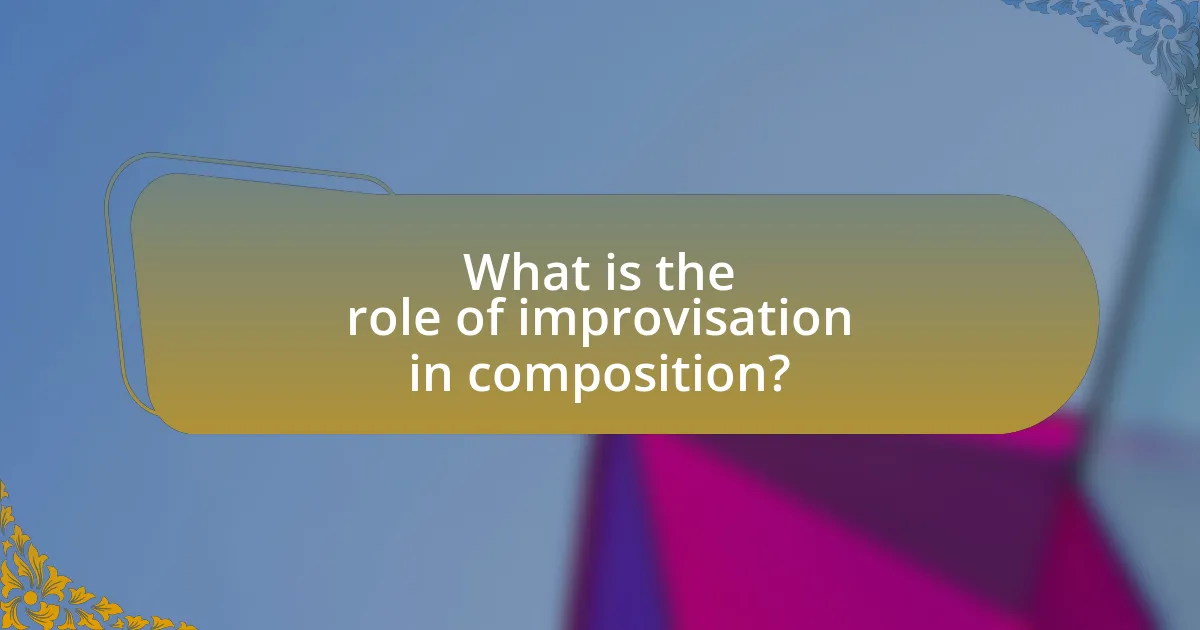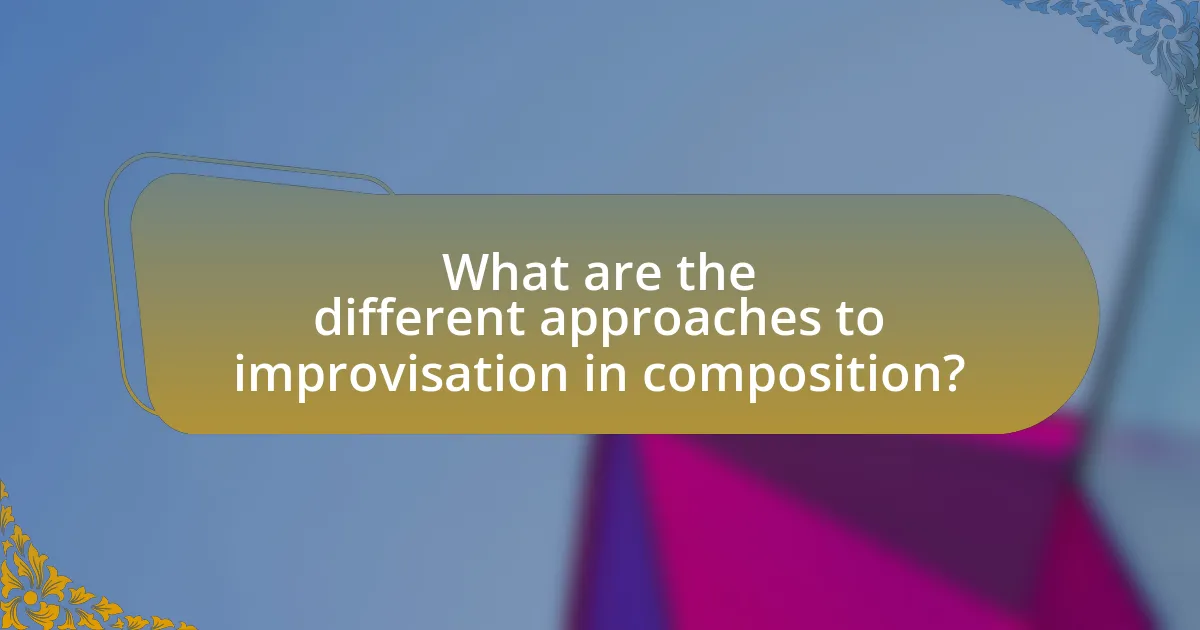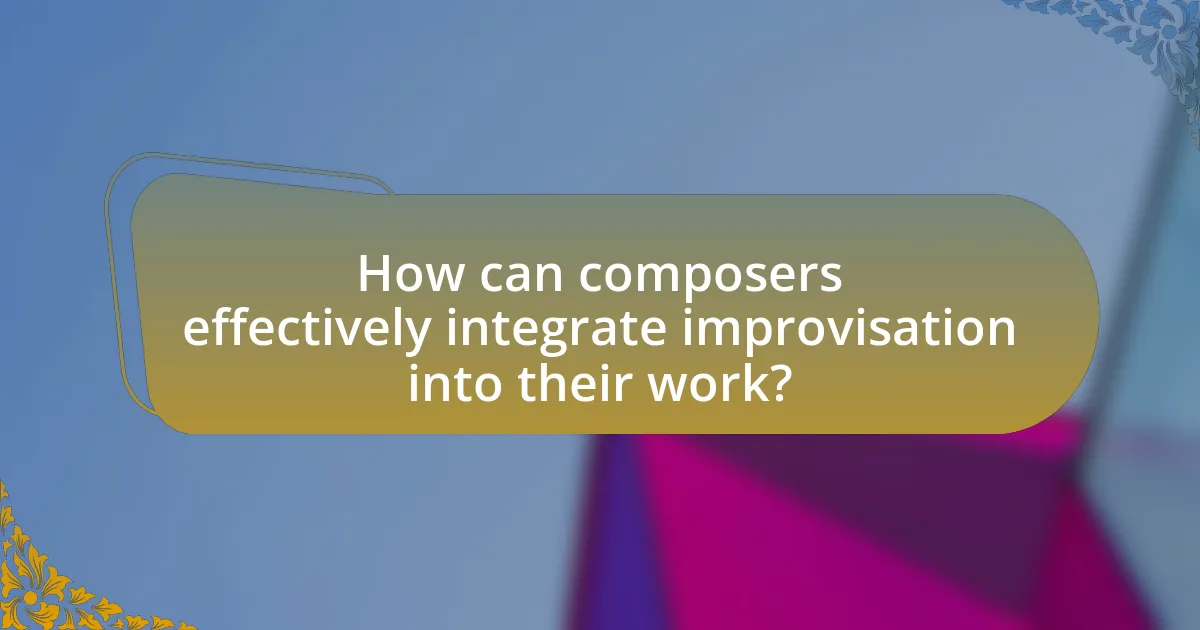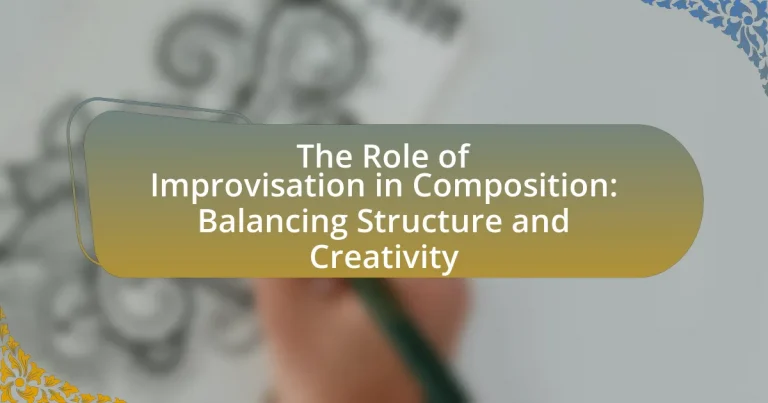The article examines the role of improvisation in musical composition, emphasizing the balance between structure and creativity. It highlights how improvisation fosters spontaneous creativity, allowing composers to explore new ideas and develop unique musical expressions. Key techniques such as call and response, motif development, and spontaneous variation are discussed, along with the influence of improvisation on audience engagement and emotional depth. The article also addresses the challenges of integrating improvisation with composition and offers practical strategies for composers to effectively incorporate improvisational elements while maintaining coherence in their work.

What is the role of improvisation in composition?
Improvisation plays a crucial role in composition by allowing composers to explore spontaneous creativity and generate new ideas. This process encourages experimentation, enabling musicians to break free from rigid structures and discover unique melodies, harmonies, and rhythms. Historical examples, such as jazz musicians who often improvise during performances, demonstrate how this practice can lead to innovative compositions that reflect personal expression and emotional depth. Additionally, studies show that improvisation can enhance a composer’s ability to adapt and refine their work, ultimately enriching the final piece.
How does improvisation influence the creative process in composition?
Improvisation significantly influences the creative process in composition by allowing composers to explore spontaneous ideas and develop unique musical expressions. This practice encourages experimentation, leading to innovative structures and themes that might not emerge through traditional compositional methods. For instance, jazz musicians often utilize improvisation to create new melodies and harmonies on the spot, which can later be refined into composed pieces. Research by David Hargreaves and Adrian North in “The Social Psychology of Music” highlights that improvisation fosters a sense of freedom and creativity, enabling composers to break away from rigid frameworks and discover fresh artistic directions.
What techniques are commonly used in improvisational composition?
Common techniques used in improvisational composition include call and response, motif development, and spontaneous variation. Call and response involves a dialogue between musicians, where one musician plays a phrase and another responds, fostering interaction and creativity. Motif development allows musicians to take a short musical idea and expand upon it, creating depth and complexity in the performance. Spontaneous variation encourages musicians to alter melodies, rhythms, or harmonies in real-time, promoting originality and adaptability. These techniques are foundational in various genres, including jazz and contemporary classical music, where improvisation is integral to the creative process.
How does improvisation enhance spontaneity in musical creation?
Improvisation enhances spontaneity in musical creation by allowing musicians to make real-time decisions that reflect their immediate emotional and creative impulses. This process fosters an environment where unexpected ideas can emerge, leading to unique musical expressions that differ from pre-composed works. Research indicates that improvisation activates different brain regions associated with creativity and emotional processing, enabling artists to explore new musical territories without the constraints of established structures. For instance, a study published in the journal “Neuroscience of Creativity” by researchers at the University of California found that improvisational musicians exhibit heightened neural connectivity, which facilitates spontaneous idea generation during performance.
Why is balancing structure and creativity important in composition?
Balancing structure and creativity in composition is crucial because it allows for both coherence and innovation. Structure provides a framework that guides the composition, ensuring clarity and organization, while creativity introduces originality and emotional depth. Research indicates that compositions that effectively integrate these elements tend to engage audiences more successfully, as they offer a familiar yet fresh experience. For instance, studies in music theory show that pieces with a clear form, such as sonata or rondo, often resonate more with listeners when they incorporate unexpected creative elements, enhancing both memorability and emotional impact.
What are the risks of relying too heavily on improvisation?
Relying too heavily on improvisation can lead to a lack of coherence and structure in creative work. When improvisation dominates the creative process, it may result in disorganized ideas that fail to convey a clear message or theme. Research indicates that structured approaches enhance creativity by providing a framework within which improvisation can flourish, as seen in studies on creative problem-solving (Runco & Jaeger, 2012). Additionally, excessive improvisation can lead to inconsistencies in style and quality, making it difficult for audiences to engage with the work effectively.
How can structure support creative expression in composition?
Structure can support creative expression in composition by providing a framework that guides the creative process while allowing for flexibility within that framework. This balance enables composers to explore innovative ideas without losing coherence in their work. For instance, established forms like sonatas or verses can serve as templates that inspire creativity, as they offer a recognizable context in which new ideas can be developed. Research indicates that constraints can enhance creativity by forcing individuals to think outside the box; a study by F. S. Osborn in 1953 demonstrated that structured brainstorming leads to more innovative solutions compared to unstructured approaches. Thus, structure not only organizes thoughts but also catalyzes creative exploration within defined boundaries.

What are the different approaches to improvisation in composition?
Different approaches to improvisation in composition include structured improvisation, free improvisation, and guided improvisation. Structured improvisation involves predefined frameworks or rules that musicians follow, allowing for creativity within set boundaries, as seen in jazz where chord progressions guide solos. Free improvisation permits complete spontaneity without predetermined structures, often utilized in avant-garde music, enabling artists to explore sound without constraints. Guided improvisation combines elements of both, where a composer provides specific prompts or themes while allowing performers the freedom to interpret them, fostering creativity while maintaining a cohesive direction. Each approach serves to balance the tension between structure and creativity in musical composition.
How do various musical genres utilize improvisation?
Various musical genres utilize improvisation as a fundamental element to enhance creativity and expressiveness. In jazz, musicians often engage in spontaneous soloing, allowing for personal interpretation and interaction with other players, which is a hallmark of the genre. In classical music, particularly in the Baroque period, performers frequently improvised embellishments on written scores, showcasing their virtuosity and interpretative skills. Rock music incorporates improvisation during live performances, where guitar solos or extended jams create unique experiences for audiences. Additionally, in Indian classical music, improvisation is central, with artists developing ragas through intricate, spontaneous variations. Each genre employs improvisation to foster individual expression while maintaining a connection to its structural foundations.
What role does improvisation play in jazz composition?
Improvisation is central to jazz composition, serving as a means for musicians to express creativity and spontaneity within a structured framework. In jazz, compositions often provide a harmonic and rhythmic foundation, while improvisation allows performers to explore melodies and variations in real-time, creating a unique musical experience. Historical examples, such as the works of Louis Armstrong and Charlie Parker, illustrate how improvisation can transform a standard piece into a personal statement, showcasing individual artistry and emotional depth. This interplay between structure and improvisation is what defines jazz as a dynamic and evolving genre.
How is improvisation applied in classical music composition?
Improvisation in classical music composition is applied as a method for composers to explore musical ideas spontaneously, allowing for creativity within structured frameworks. Historically, composers like Johann Sebastian Bach and Wolfgang Amadeus Mozart utilized improvisation as a fundamental aspect of their creative process, often composing in real-time during performances or while developing new works. This practice not only fosters innovation but also enhances the emotional expressiveness of the music, as seen in the cadenzas of concertos where performers improvise elaborate passages. The integration of improvisation into classical composition thus serves to balance the rigidity of formal structures with the fluidity of artistic expression.
What are the benefits of incorporating improvisation into structured compositions?
Incorporating improvisation into structured compositions enhances creativity, spontaneity, and emotional expression. This integration allows composers to break free from rigid frameworks, fostering innovative ideas that can enrich the overall work. Research indicates that improvisation can lead to increased engagement and a deeper connection with the audience, as it often reflects genuine emotional responses. For instance, studies have shown that musicians who incorporate improvisational elements report higher levels of satisfaction and artistic fulfillment, which can translate into more compelling performances.
How does improvisation foster innovation in musical works?
Improvisation fosters innovation in musical works by allowing musicians to explore spontaneous creativity and develop unique expressions that deviate from traditional structures. This process encourages experimentation with new sounds, rhythms, and harmonies, leading to the creation of original compositions. Historical examples include jazz musicians like Miles Davis, who utilized improvisation to redefine musical boundaries, resulting in groundbreaking albums such as “Kind of Blue,” which introduced modal jazz and influenced countless artists. Thus, improvisation serves as a catalyst for artistic evolution, enabling musicians to push the limits of their craft and inspire new genres.
What impact does improvisation have on audience engagement?
Improvisation significantly enhances audience engagement by fostering a dynamic and interactive experience. When performers incorporate improvisation, they create a sense of spontaneity that captivates the audience’s attention and encourages emotional investment. Research indicates that audiences are more likely to feel connected to performances that include improvisational elements, as these moments often evoke genuine reactions and responses. For example, a study published in the Journal of Applied Arts and Health found that improvisational performances led to higher levels of audience satisfaction and participation compared to strictly scripted shows. This engagement is rooted in the unpredictability of improvisation, which keeps the audience alert and involved, ultimately enriching their overall experience.

How can composers effectively integrate improvisation into their work?
Composers can effectively integrate improvisation into their work by establishing a framework that allows for spontaneous creativity within structured guidelines. This approach enables composers to maintain a balance between predetermined elements and the freedom of improvisation, fostering innovation while ensuring coherence in the composition. For instance, jazz composers often use chord progressions as a foundation, allowing musicians to improvise melodies and solos that enhance the overall piece. Historical examples include the works of composers like Igor Stravinsky, who incorporated improvisational elements in his compositions, demonstrating that structured improvisation can lead to unique and compelling musical outcomes.
What strategies can composers use to balance improvisation and structure?
Composers can balance improvisation and structure by employing strategies such as establishing a clear framework while allowing for spontaneous expression within that framework. For instance, composers can create specific chord progressions or thematic material that serves as a foundation, enabling improvisation to occur over these established elements. This method is supported by the practice of jazz musicians, who often use predetermined chord changes to guide their improvisation, allowing for creativity while maintaining coherence. Additionally, composers can set time limits for improvisational sections, ensuring that the overall structure of the piece remains intact while still encouraging creative exploration. This approach is evident in the works of composers like Igor Stravinsky, who integrated improvisational elements within structured forms, demonstrating that a balance can be achieved through thoughtful design.
How can practice and experimentation enhance improvisational skills?
Practice and experimentation enhance improvisational skills by allowing individuals to explore various techniques and approaches in real-time scenarios. Regular practice builds a strong foundation in fundamental skills, enabling performers to react instinctively during improvisation. Experimentation introduces new ideas and methods, fostering creativity and adaptability. Research indicates that musicians who engage in consistent practice and diverse experimentation demonstrate improved spontaneity and innovation in their performances, as evidenced by studies showing that improvisational musicians often have higher levels of creative thinking and problem-solving abilities.
What role does collaboration play in the improvisational process?
Collaboration is essential in the improvisational process as it enhances creativity and fosters a dynamic exchange of ideas among participants. When individuals work together, they build on each other’s strengths, leading to innovative outcomes that may not arise in solo efforts. Research indicates that collaborative improvisation can result in more complex and engaging performances, as seen in jazz ensembles where musicians respond to one another in real-time, creating a rich tapestry of sound that reflects collective input. This synergy not only enriches the artistic experience but also cultivates a sense of community and shared ownership over the creative process.
What are some common challenges faced when blending improvisation with composition?
Common challenges faced when blending improvisation with composition include maintaining coherence while allowing for spontaneity, balancing structure with creative freedom, and ensuring that the improvisational elements enhance rather than detract from the overall composition. Musicians often struggle to integrate the unpredictability of improvisation with the planned aspects of composition, which can lead to disjointed musical ideas. Additionally, the need for a clear framework can restrict the improviser’s creativity, making it difficult to achieve a seamless fusion of both elements.
How can composers overcome the fear of losing control in improvisation?
Composers can overcome the fear of losing control in improvisation by establishing a framework of guidelines or structures within which they can create. This approach allows composers to feel secure while still exploring their creativity. For instance, using specific scales, chord progressions, or rhythmic patterns can provide a sense of direction and control during improvisation. Research indicates that structured improvisation can enhance creativity while reducing anxiety, as it allows for spontaneous expression within defined boundaries. This method has been supported by studies in music education, which show that students who practice improvisation within a structured context report increased confidence and reduced fear of failure.
What techniques can help maintain coherence in improvisational compositions?
Techniques that can help maintain coherence in improvisational compositions include thematic development, call and response, and the use of a consistent rhythmic structure. Thematic development allows musicians to build upon a central idea, creating a sense of unity throughout the piece. Call and response fosters interaction among performers, reinforcing connections between musical phrases. A consistent rhythmic structure provides a framework that guides improvisation, ensuring that the performance remains cohesive. These techniques are supported by the understanding that coherence in music often arises from the interplay of structure and spontaneity, as demonstrated in various improvisational genres such as jazz and classical music.
What practical tips can help composers successfully use improvisation?
Composers can successfully use improvisation by establishing a clear framework within which to explore their creativity. This involves setting specific parameters, such as key, tempo, and form, which guide the improvisational process while allowing for spontaneous expression. Research indicates that structured improvisation can enhance creativity by providing a balance between freedom and constraint, as seen in studies on jazz musicians who thrive within defined musical contexts. Additionally, regular practice of improvisation can build confidence and skill, enabling composers to integrate spontaneous ideas into their compositions more effectively.


